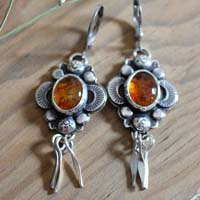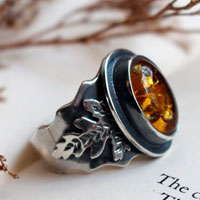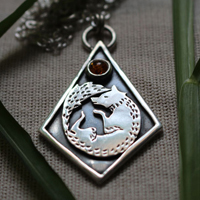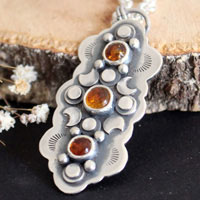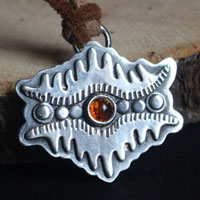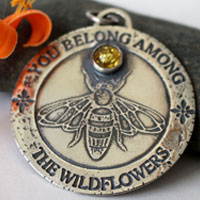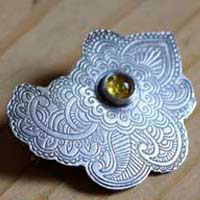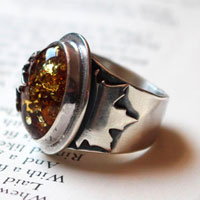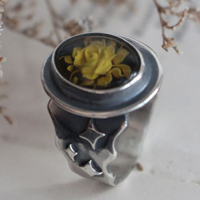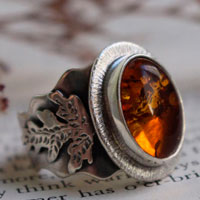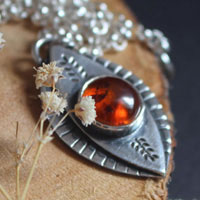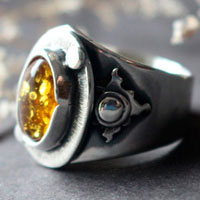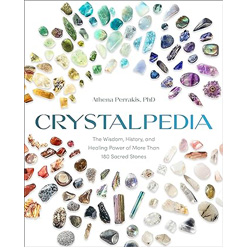- Jewelry
- Inspiration
- Good Deals
- Paintings
- About
- Contact
JEWELRY
- Anklet
- Bracelets
- Brooches
- Cufflinks
- Earrings
- Pendants & Necklaces
- Rings
- Draw your jewelry
- GOOD DEALS
- How to clean your jewel
- Metal we used
INSPIRATION
- Our imagination
- Birthstones
- Druids and druidesses
- Flower meanings
- History, archeology jewelry
- Japanese symbols
- Lithotherapy and stone choice
- Illumination jewelry
- Maya calendar jewelry
- Stone color symbolism
- Stones Catalogue
- Searches a theme on the site
ABOUT
Amber: history, healing properties and lithotherapy

Amber properties

Amber, a resin originating from trees dating back 25 to 40 million years, has undergone fossilization, transforming it into a hard organic gem, akin to mother-of-pearl and coral.
Distinguishing itself from sap, resin is an aromatic semi-solid secretion, often resulting from a protective reaction in conifers. This sweet molasses acts as a defensive response, eliminating diseases, injuries, fungi, healing broken branches, and expressing the plant’s stress.
As an organic gem, amber embodies a petrified treasure, offering a unique connection to the geological past and the vitality of trees from a bygone era.
The term "amber" derives from the Arabic "anbar," meaning "that which floats on the sea" or "ambergris," used to refer to the intestinal concretions of the sperm whale. Like plant-based amber, it was once harvested by floating on water or washing ashore, explaining the confusion. It is also known by the names succin or carabe.
Amber harbors countless inclusions preserved over time, such as plants, insects, animals, feathers, hair, and even air bubbles. Insects, drawn to the resin’s sap, remain trapped for eternity in this organic gem.
Baltic amber specimens boast over 214 captured plant species, offering a fascinating glimpse into ancient biodiversity preserved in this precious gem.
The different types of amber
Amber comes in various forms, showcasing a color palette ranging from pale whitish-yellow to richer hues of yellow, orange, and brown. It can be either opaque or transparent. Some specimens may also display rare tones such as red and green. However, among the most exceptional varieties, blue amber remains particularly rare, captivating collectors with its uniqueness and distinctive beauty. The different colors of amber contribute to its visual allure and diversity, making this organic gem a natural wonder with multiple facets.
- Blue Amber: Exclusive to the Dominican Republic, blue amber remains an enigma, with its rarity raising questions about its origin. Some suggest possible fluorescence or an association with volcanic ashes, adding a captivating mystery to this unique gem.
- Yellow Amber: The most widespread, yellow amber exhibits a range of colors from pale to brown. Its versatility makes it a prized option, capturing the warmth and rich tones that evoke the ancient history of this fossilized resin.
- Black Amber: Also known as azabache, this variety is often composed of fossilized wood or charcoal. Abundant and economical, black amber offers an accessible alternative while retaining the timeless charm of this ancient gem.
- Red Amber: Originating from Chiapas, Mexico, and the Dominican Republic, red amber, often called "cherry amber," is believed to come from the fossilized resin of deciduous trees like plum or cherry. Its distinctive hue adds a vibrant touch to the amber palette.
- Green Amber: Relatively rare, green amber mainly comes from the Caribbean Sea, revealing a distinctive shade. Its rarity and soothing color make it a sought-after choice, capturing the unique essence of this organic gem.
How to recognize amber and counterfeiting
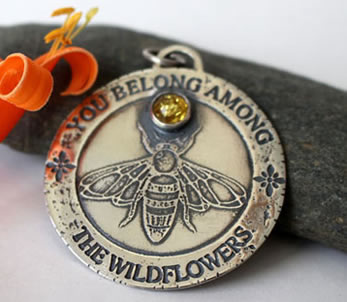
Due to the rarity of certain amber varieties, a market for counterfeits has emerged, utilizing materials such as plastic, glass, and copal.
Copal is a tree resin primarily found in Mexico and Central America. Even when hardened, it is far from the solidification state of amber but can easily pass for this highly sought-after material.
Forgers often specialize in creating amber with inclusions, a feature prized by buyers. Their focus is particularly on rare inclusions such as scorpions, vertebrates, or flowers, adding an artistic and sought-after dimension to their imitations. Amber enthusiasts must exercise increased vigilance to distinguish the authenticity of these unique pieces from reproductions.
Numerous tests are available to detect fake amber, although their application can sometimes irreversibly damage the stone. Here are some common methods:
- Heat Test: By placing a needle heated to white on the stone, an odor of pine will emanate if it is authentic (amber or copal), leaving a white mark. Plastic, on the other hand, will emit a pungent smell, leaving a black and sticky mark.
- Acetone Test: Rubbing the stone with acetone will not alter authentic amber but may melt plastic and make copal sticky.
- Scratch Resistance Test: Scratching the stone with a knife will reveal that amber and copal crumble, while plastic will not be affected in the same way.
- Floatation Test: Submerging the stone in a mixture of water and salt will show that amber and copal float, while plastic sinks.
- Static Electricity Test: Rubbing amber with a cloth will make it highly static, attracting hair or small papers. Plastic, in general, does not exhibit this property as pronouncedly.
When it comes to amber with inclusions, a dose of common sense is essential. Specimens containing whole plants or animals, particularly well-preserved in amber, remain extremely rare. If the piece is exceptionally beautiful, it would be logical to expect it to be found in a museum or to be sold at a considerably high price. The rarity of such well-preserved inclusions not only contributes to their monetary value but also to their status as unique pieces, making each specimen a precious work of art from nature.
Mines: Baltic Sea, Poland, Germany, Lithuania, Estonia, Russia, Canada, Dominican Republic, Mexico, France, Burma
History, legends and beliefs about the amber
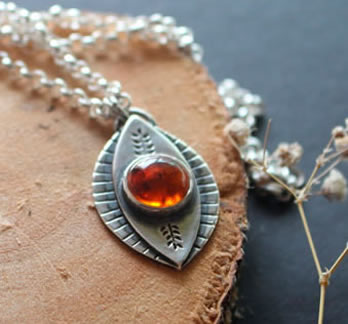
Amber has always exerted fascination on humans, often perceived as drops of sunlight, divine tears, solidified honey, or even frozen sunshine.
Due to the frequent presence of inclusions such as trapped plants or animals, it has often been associated with the idea of eternal youth. This connotation has led to the association of amber with funeral rites, where it accompanies the deceased in many cultures.
The use of amber as jewelry or art objects dates back to prehistoric times, with traces dating back to the early Aurignacian period. The oldest piece of amber worked by humans, dating back thirty thousand years, was discovered in Germany.
The Baltic Sea is recognized as the oldest known source of amber, supplying all ancient cultures in Europe, from the Greeks to the Egyptians, and including the Celts and the Mycenaeans. This precious fossilized resin has thus traversed the centuries, becoming a timeless symbol of beauty and mystery.
The Greeks, pioneers in the study of amber, left traces of their fascination and analyses. The Greek naturalist Pliny the Elder (23, 79) was the first to document its properties, although Thales of Miletus (-625, -547) had previously explored its electrostatic characteristics. This discovery dates back to an ancient time when the Greeks observed static electricity generated by rubbing amber against other objects. The word "electricity" actually finds its origin in the Greek "elektron," meaning amber.
A famous Greek myth attributes the origin of amber to the resin of poplars and alders. According to the legend, Phaeton, son of the sun god Helios, attempted to drive his father’s solar chariot. Losing control, he came too close to the earth, causing drought and fire on land. To stop this chaos, Zeus struck him down with lightning. The tears of Phaeton’s sisters, the Heliades, solidified into amber, and the gods transformed them into alders and poplars, whose tears continued to flow into the river Eridanus. This mythological tale adds a poetic dimension to the formation of amber, linking its creation to celestial tragedies and the eternity of frozen tears.
Another legend, reported by Sophocles, links amber to the tears of the sisters of Meleager, transformed into birds mourning the loss of their brother. This tale adds a poignant dimension to the formation of amber, suggesting that even grief and tears can crystallize into a precious and eternal substance.
Amber, often perceived as a fragment of solidified sunlight, was dedicated to the Greek god Apollo. As the deity of song, music, poetry, purification, healing, and light (distinct from the sun), Apollo was associated with amber due to its ability to warm the heart and transmit solar energy. This divine connection reinforces the perception of amber as a celestial gift, linked to the brightest and most energetic aspects of life.
Amber held considerable value, as evidenced by its role in the epic of the Odyssey, where a suitor offers an amber necklace to Penelope, the wife of Odysseus, in an attempt to seduce her. This anecdote underscores the high esteem in which amber was held as a precious and seductive gift.
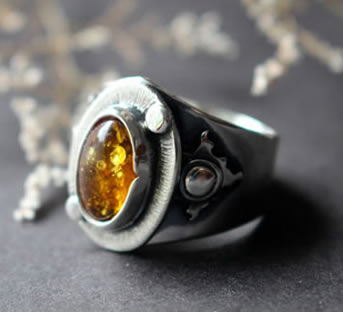
In Roman times, women frequently wore amber bracelets, believing that it could preserve eternal youth. This usage reflects the perception of amber as a symbol of timeless beauty and a direct connection to the vitality and radiance associated with youth.
For the ancient Baltic peoples of Lithuania, amber finds its origin in the tragic tale of the mermaid goddess, Juraté. Engaged out of obligation to Patrimpas, the god of waters and seas, the divine couple resided in a splendid amber palace at the bottom of the sea, symbolizing the source of all life. However, Juraté's forbidden love for a young fisherman triggered the wrath of Perkūnas, the god of rain, mountains, oaks, and the sky. His lightning destroyed the palace, causing the death of the fisherman. Juraté, chained to the ruins of her domain, was condemned to be beaten by the waves. Her tears, transforming into amber, litter the beaches alongside the remnants of her sunken palace.
The Celts, captivated by amber, used it extensively in the form of beads. In Celtic mythology, Apollo (the Latin adopted form of Apollon), banished from Olympus, is said to have scattered tears of amber.
In Norse mythology, amber is believed to be formed from the tears of the goddess of love and beauty, Freyja, adding an emotional and romantic dimension to this precious stone. The belief that amber figurines sculpted in the shape of animals could contain their strength reinforces the mystical connection with natural forces and animal symbolism.
In medieval France, the use of powdered amber in love potions illustrates its association with romantic and magical rituals, where this gem was considered a potent element to attract love.
In China, the depiction of animals in amber was believed to promote fertility. There is also a theory that amber could be the eternal soul of imprisoned tigers.
Amber weddings, celebrated on the 34th anniversary of marriage, emphasize the durability and memory encapsulated in amber, trapping plants and animals for eternity.
Healing properties and benefits of amber
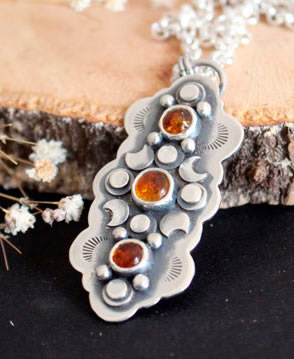
- Amber, renowned for its ability to support the digestive system, is believed to bring extensive benefits by treating the kidneys, bladder, spleen, liver, and gallbladder, highlighting its positive impact on internal health.
- Its traditional use extends to the treatment of epilepsy, vision problems, nervous tics, and circulatory issues, showcasing its versatility in supporting various systems of the body.
- When worn as a necklace, amber proves to be a soothing remedy for children, alleviating the discomfort associated with teething pain, providing a natural and gentle means to relieve infantile discomfort.
- The resin that forms amber, acting as a protective and healing mechanism for the tree, is associated with therapeutic virtues. Amber is credited with the ability to heal wounds, promote healing, and restore energy, establishing a connection between its organic properties and beneficial effects on well-being.
- Due to its electrostatic properties, amber is considered a potential ally in treating impotence and frigidity, suggesting an alternative approach to sexual health.
- The virtues of amber extend to the treatment of goiter and throat disorders, underscoring its role in relieving ailments related to this part of the body.
- Recognized for its analgesic effects, amber is used to alleviate joint pain, rheumatism, and toothaches, providing a natural relief for these common ailments.
⚠ Please note that all healing properties presented for gemstones are gathered from various sources. This information is provided as a service and is not intended to treat medical conditions. It is recommended to consult a healthcare professional for serious medical issues and not to rely solely on gemstones as a treatment.

